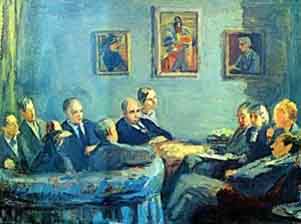
The Bloomsbury Group
Blooms bury is a popular collective designation for a number of English intellectuals prominent in the first quarter of the 20th century, all of whom were individually known for their contributions to the arts or to social science. Although the group was primarily social and had no unified platform, its members criticized one another's work and were all devoted to experimentation. Their painting and literature, perhaps best characterized as modernist, were chiefly motivated by a strong reaction against the monumental formalism and sterile realism of the late 19th century. The name of the group is derived from a residential district near the British Museum in central London where most of the members lived. They included the writers Virginia Woolf and her husband, Leonard Sidney Woolf; the art critics Roger Fry and Clive Bell; the economist John Maynard Keynes; the biographer Lytton Strachey; the literary and drama critic Desmond MacCarthy; the novelist and essayist E. M. Forster; and the painters Vanessa Bell(Virginia’s sister and Clive Bell’s wife) and Duncan Grant; a psychoanalyst Toby Stephen(Virginia and Vanessa’s brother) and a civil servant Saxon Sydney-Turner.
Almost everything about Bloomsbury appears to be controversial, including its membership and name. Group, for example, is the best general classification rather than set, as some think which implies their cohesion was simply social. They also never 'held' formal or informal discussions of anything, but talked about all kinds of things all the time.
Vanessa Bell and Virginia Woolf were sisters, and their brothers, the older Thoby and the younger Adrian, were also original members of the group, as were some other Cambridge figures such as the enigmatic Saxon Sydney-Turner. Lytton Strachey and Duncan Grant were cousins.
A remarkable historical feature of these friends and relations is that their close relationships all predated their fame as writers, artists, and thinkers.
Their convictions about the nature of consciousness and its relation to external nature, about the fundamental separateness of individuals that involves both isolation and love, about the human and non-human nature of time and death, and about the ideal goods of truth love and beauty – all these were largely shared, underlie the group’s core dissatisfactions with capitalism and its wars of imperialism. These "Bloomsbury assumptions" are also reflected in member's criticisms of materialistic realism in painting and fiction as well as attacks on what Bloomsbury group members saw as repressive practices of sexual inequality, and in attempts to establish a new social order based upon liberation from these established norms.
After Virginia Woolf’s death Leonard Woolf began editing collections of her writings including a selection from her diaries, A Writer’s Diary (1953), which revealed publicly for the first time what the Bloomsbury Group had been like. Leonard’s own volumes of autobiography in the 1960s (he died in 1969) gave the fullest account. Subsequent biographies of Strachey then Virginia Woolf, Forster, Keynes, Fry, Vanessa Bell, and Grant removed all veils. Indeed much of the interest in Bloomsbury has been biographically driven, yet it is their achievements as writers, artists, and thinkers that have ultimately made their lives biographically interesting. The case of Virginia Woolf provides an example. There have now been more than half a dozen biographies of her, yet a good deal of the basic scholarship of locating and editing her work remains unfinished; significant unpublished writings of hers are still being found in library archives.
sources: encarta encyclopedia
wikipedia.com
therem.net
